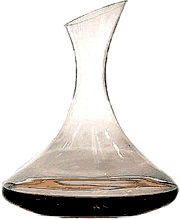When I teach
aspiring Wine Captains about decanting wine, I tell them that there are
three “Official” reasons for decanting, and one “Insider’s”
reason:
1. Big bottles, such as double magnums, are awkward to pour from. It is
easier, and you will spill less, if you pour from the bottle into a decanter,
then fill the glasses from the decanter. I have always loved big bottles.
They’re so much fun to open at a party, and they make an impressive
gift. Opening a larger bottle seems to make it more of a special occasion,
but pouring from such a heavy bottle can often lead to accidents. Show
off the bottle, open it, and fill up your decanter.
2. Young wines, especially reds, will improve from the aeration the wine
receives from decanting. The flavors and aromas will open up, the wine
will taste softer and will drink better. Simply opening a bottle and letting
it stand there, with a surface area smaller than a penny exposed to the
air does nothing to help the wine “breathe”. Try it for yourself:
the next time you open a bottle, pour a sip into your glass and taste
it. Then decant the rest, let it stand for a few minutes and pour another
taste. You’ll be surprised at the difference a bit of breathing can
make!
3. Older red wines usually accumulate sediment with ageing. In decanting,
you pour the wine into another vessel, leaving the sediment behind. The
combination of tannins and pigments in some reds form long molecules called
polymers that, in time, will sink to the bottom of the bottle. Vintage
Porto “throws” lots of sediment, Bordeaux reds throw a good
amount, but lighter reds such as Burgundy rarely do. You can tell if there
is sediment in the bottle by holding it up to a bright light. To decant
your wine, let the bottle stand upright, undisturbed, for at least a day.
Without shaking the bottle (which would stir up the sediment) remove the
cork. Slowly pour the wine into a decanter while, using a short candle
as a light source, look down through the neck of the bottle. When the
sediment moves up the bottle, you’ll be able to see it clearly. Pour
carefully, letting the sediment catch in the shoulder of the bottle, and
you’ll lose only a spoonful of sediment and have clear wine to enjoy.
Vintage Porto comes in bottles so dark that it is almost impossible to
see through the glass. To decant one of these treasures, you can place
a funnel into the mouth of the decanter and line it with a few layers
of rinsed cheesecloth, squeezed dry. Slowly pour the Porto into the funnel
and let the cheesecloth filter out the sediment.
4. The “Insider’s” reason for decanting: just for the sheer
pleasure of it. A good friend of mine won’t allow a bottle on her
table, insisting on using one of her English Claret jugs to serve wine.
A decanter does not have to be fancy, expensive or ornate: a pitcher or
a jug will do. I have a few crystal decanters, and the ones I always seem
to use are well-designed yet quite plain, but I like a more modern look
than many do. I just prefer serving myself and my friends from a decanter.
The wine really does taste better, and it seems so elegant to pour even
a simple, everyday wine from a beautiful decanter Like a glass of wine,
it’s part of the good life.

























